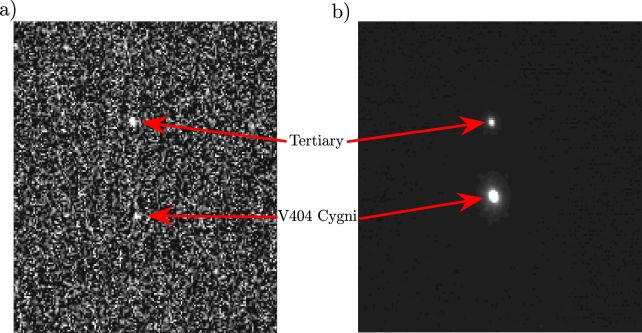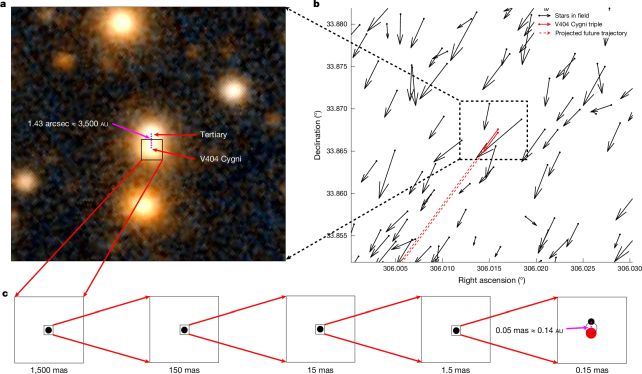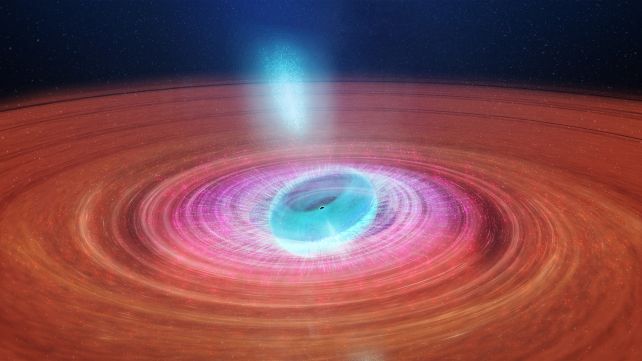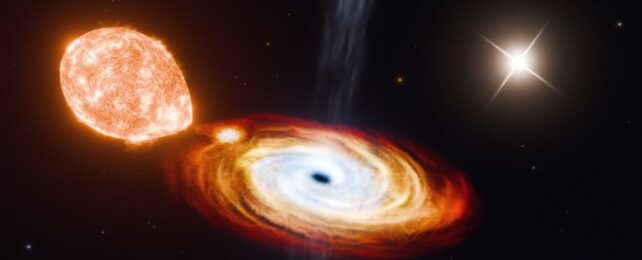In the constellation of Cygnus, some 7,800 light-years from Earth, lurks a real space oddity. There, a black hole in a system named V404 Cygni repeatedly engages in behavior that has simultaneously baffled and delighted scientists.
Now it's whipped a brand new trick out of its seemingly endless arsenal: an unseen binary companion, a star on a wide orbit of around 70,000 years.
Since V404 Cygni already has a companion – a star on a close, 6.5-day orbit, on which the central black hole is leisurely feasting – the newly discovered third object makes the system a trinary.
It's the first time we've seen a system with this configuration, and it could offer some insights into how black holes form. This is because a supernova explosion, thought to be the mechanism by which stellar-mass black holes form, should have snapped the tenuous gravitational bond of a wide orbit.
"We think most black holes form from violent explosions of stars, but this discovery helps call that into question," says physicist Kevin Burdge of the Massachusetts Institute of Technology.
"This system is super exciting for black hole evolution, and it also raises questions of whether there are more triples out there."
We've known about the second star, in fact, for decades; astronomers thought it was just a star close to V404 Cygni, which would be relatively unremarkable.

But data collected by the European Space Agency's Gaia mission revealed that there's definitely more going on there than we thought. Gaia is mapping the three-dimensional positions of the objects in the Milky Way galaxy; but it's also mapping their direction and velocity as they move through space.
V404 Cygni and the seemingly unrelated star are moving through space in the same direction and at the same speed. That shows the objects are linked.
"It's almost certainly not a coincidence or accident," Burdge says. "We're seeing two stars that are following each other because they're attached by this weak string of gravity. So this has to be a triple system."
There's evidence out there for the supernova model of black hole formation. This is when a dying star erupts in a colossal explosion, ejecting its outer material, while the core of the star collapses under gravity to form a black hole, the densest object in the Universe.
Scientists have seen supernovae, and disentangled the light to gauge the mass of the object at the core to infer the production of a black hole. But that doesn't mean that a supernova is the only formation mechanism. Another option is the direct collapse model. Here, the massive star simply implodes, completely, into a black hole, no mess, no fuss.

Here, the evidence is a little more difficult to come by. With no mess or fuss, there's pretty much an absence of evidence.
This is where V404 Cygni suddenly becomes very interesting indeed – because when a supernova explosion is asymmetrical, which they often are, the imbalance in energy can give the nascent black hole a directional kick.
This is difficult to resolve with such a wide orbit as seen with the newly connected star. The black hole and the star are separated by a distance of 3,500 astronomical units, which makes their gravitational tether to each other relatively weak. The disruption introduced by a supernova should have broken that tether like a wisp of cobweb.
The wide orbital separation also makes gravitational capture between two passing objects challenging to explain. Burdge and his colleagues conducted tens of thousands of simulations, and found that the best explanation is that the three objects were already gravitationally bound when the black hole formed; and that the formation mechanism was direct collapse.

"The vast majority of simulations show that the easiest way to make this triple work is through direct collapse," Burdge says.
It's the best evidence yet for the direct collapse model of black hole formation, which bolsters the mechanism as a valid way to interpret black holes whose formation history is difficult to resolve with a supernova.
There may very well even be other wide black hole-inclusive trinaries out there that we have missed due to black holes' stealthiness; finding them could help us better understand how these objects form, and why a black hole might collapse directly rather than exploding in a blaze of light.
"Either we got very lucky, or tertiaries are common," says astronomer Kareem El-Badry of Caltech.
"If they are common, that might solve some of the long-standing questions about how black hole binaries form. Triples open up evolutionary pathways that are not possible for pure binaries.
"People have actually predicted before that black hole binaries might form mostly through triple evolution, but there was never any direct evidence until now."
The research has been published in Nature.
